
|

|
| Use the text links for more information! |
No Sidebar Pub Crawl or Bygone Pubs Menu?? |
| The Exeter Inn | Denley's Wine Bar |
| The Lord Nelson Inn | Drake's Wine and Alehouse |
| The Salutation Inn | The Globe Hotel |
| The Lighter Inn | The Steam Packet |
| The Passage House | The Bridge Inn |
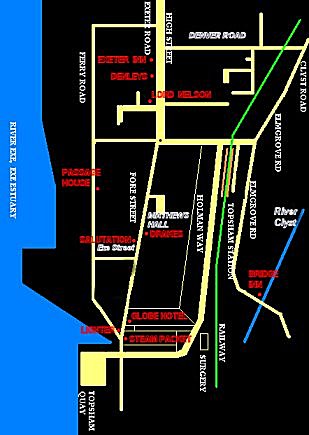 | Introduction
Topsham history of pubs, Topsham pubs, pubs history, Topsham Inns, history of Topsham Quay, Topsham Ten, Turf Locks
Topsham; isn't that where all the teachers, professors, academics and Diana suitors live? Rhetorical question, yes it is. I have been an Exeter citizen now for 33 years and only visit Topsham for the odd pub crawl and for taking my daughter to the excellent swimming club on Tuesday nights during the summer. She swims up and down like a dolphin. Rivetting! This was one of the reasons I procurred a John Smiths cardboard cut-out and sat it in my chair by the poolside while I strolled around Topsham one pub at a time. Its called research and she never noticed I was gone. Topsham has always been the big gap in my website, one that will now be partially closed. Leanne's swimming lessons have allowed me the opportunity to do this. Special thanks to Jack Dee and the volunteers at Topsham Swimming Club. The plan as ever is to get arse-faced and learn a bit of history while walking between Topsham's ten pubs, the infamous Topsham Ten. My plan is to tell the history of Topsham from the beginning in Roman times to the present day. Simple? I don't think so. Topsham history does seem to have been ignored in favour of it's more illustrious historical partner, Exeter and for that reason there will be many years of historical silence. Months of scouring bookshops and libraries for information yielded very little. I was only able to find snippets of information tied in with that of Exeter. One ray of light though, EM Carus Wilson's, "The Expansion Of Exeter at the close of the Middle Ages", (1961), an Exeter University publication that was part of the Harte Memorial Lecture. This lecture forms the basis of the story of Topsham. |
|
Your first stop is The Exeter Inn. This is one of the few
remaining thatched buildings in Topsham but is however fairly modern inside with one open-plan room, bar, pool table
and darts. A locals pub at the Exeter end of town.
Topsham was first documented as a settlement in Roman times but it is very likely that there was some form of settlement here prior to the Roman invasion of Britain. Topsham now has a population of just over 5000 and was granted "town" status by Edward I on 22nd August 1300. Since the C11th, the Parish had belonged to the Minster Church in Exeter and these boundaries have remained unchanged ever since. The parish was incorporated into Exeter in 1932, when it beacame part of Heavitree Parish, finally being incorporated into the City Of Exeter in 1966, but was for many years prior to this, considered Exeter's Port. Topsham is often referred to as Apsam or Toppisham in old documents, possibly derived from the Saxon, Toppa's Ham, meaning Toppa's estate. Aethelstan granted a charter for the manor of Toppesham in 937. Sup up and head towards Topsham town centre. Next stop is Denley's on your right. |
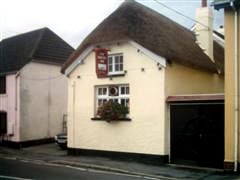 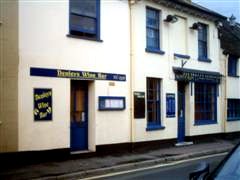 |
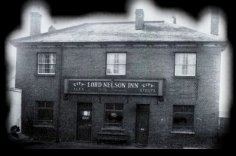  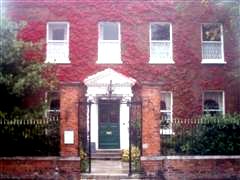 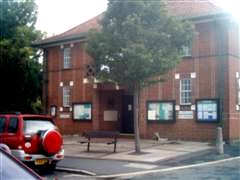 |
Denley's has incorporated an Indian Restaurant behind the main bar
area since 2001, known as Saffron. The food is excellent. I saw a feature on telly not so long ago (July 2004) where the
restaurant had delivered a take-away to the Middle East at a cost of 2000 GBP. Denley's is a wine bar and was as such before
2001. The bar area is a little crowded because of the support pillars being in just the wrong place but apart from that
the place is excellent with good beers being served. Some seating areas are slightly raised and it is sometimes a little
like being in a shop window. Different!
In the late C14th, Exeter was a very modest provincial town notable only for it's Cathedral, it had a population of around 3000 people (poll tax returns of 1377) and during this last century of feudalism was constantly reminded of the tyrranical power of the Earls Of Devon based at Powderham Castle just over the Exe Estuary from Topsham. In 1282 Lady Isabella de Fortibus decided that a barrier should be placed across the river at a place now named after her, Countess Wear. Ships were initially able to pass through the barrier until Hugh de Courtenay closed the gap in 1311. Thus trade was blocked to Exeter forcing trade through the Earl's own port of Topsham. Though trade was fairly insignificant at the time, this trade was to grow and grow making Topsham and in turn Exeter wealthy. Finish up and head off down Topsham High Street. The Lord Nelson is now a proper pub again but from around 2000 until September 2008 only served drinks if you ate. It was herefore a restaurant. In November 2008, it re-opened under new ownership as a proper pub. The black and white photo shows how the pub looked in 1954. Keep walking across the mini-roundabout into Fore Street and you'll find Drake's Wine and Alehouse on the left past Mathews Hall. You'll notice the superb Georgian architecture of Broadway (built 1776) on your left. Grove House stands on the corner of Fore Street, again Georgian but slightly later than Broadway. It was the home of the Holman family in the C19th. As for Mathews Hall, it was originally built as the Tivoli Cinema in the 1920's but has ceased functioning as such and now is used as a community hall. The area around the hall is Topsham's leisure area with bowls, tennis and swimming. |
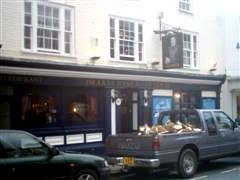
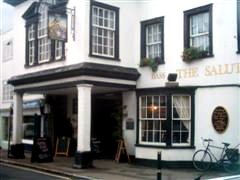 |
Drake's Wine and Alehouse
has a very good selection of beers and is larger than it looks with an upstairs area featuring sofas and all that
trendy shite, wood panel etc..Downstairs is better with snugs and a big open fireplace. This building and those
around it date from the late C17th, this one in fact was once the Western Union Hotel. Many houses in Topsham's centre date
from the C17th and a few from the C14th. These C14th buildings are to be found mainly where Fore Street winds down to
Topsham Quay.
Tryphena Sparks, used to live next door at the antique shop (N0.13). She was supposedly a sweetheart or lover of Thomas Hardy, depending upon which biography you read. She married the publican of the Western Union Hotel, Charles Frederick Gale on 15th December 1877. They raised a family. Four children were born to them; Eleanor Tryphena,
(1878), Charles (1880), George (1882), and Herbert (1886). Sometime after
the birth of Herbert she suffered a "rupture". Her health suffered until she died
three days before her 39th birthday, on 17th March, 1890. She is buried in Topsham.
During the reign of Richard II, the commercial boom enjoyed by many English ports largely passed Exeter and Topsham by.
Exeter and East Devon had little to export and coarse Devon wool was not in great demand. 40,000 cloths were exported from
English ports during Richard's reign and Devon's contribution, mostly through Topsham was only 400. A few further consignments
of hide or fish did not qualify Topsham as a great port. The Hundred Years war fought with France had effectively crippled
the wine trade with bordeaux which had previously brought profit to the people of Devon. Exports from bordeaux during this
period were down by 80%. The wine trade did however recover in the late C14th but this again largely passed Topsham and Exeter
by, Southampton becoming an important wine port. Out of the 12000 tuns of wine reaching England in the late C14th, only 300
tuns came into Devon and not all through Topsham. Things were looking a little bleak.
|
|
The Salutation Inn is an old coaching inn and dates from 1720. Large
sash windows, an impressive looking building. Years ago this place used to look a little threadbare but has fairly
recently been renovated. It was rebuilt in 1768 with the addition of the venetian window over the projecting porch, the door
below though is C17th. The frame of the door appears to have been cut away in order to have given better headroom for the
stage-coaches.
The sectioned off public bar can get very crowded. There are the ubiquitous sofas but this time with a baby grand piano making it all look a bit more authentic. Authentically what!? I think the idea is 1920's chic but I aint sure. There is also a dining section and a beer garden with more flowers than a Laura Ashley print. Pretty good beers considering this is the fifth pub. My sense of taste has normally deserted me by now. The Fencibles were based here in 1774, these people kept a keen eye on the coastline in case of French invasion. They
were only in existence for about 8 years but even so, their colours can be seen in St Margarets Church.
The Inn closed in November 2008 after the landlord had got himself into trouble. Hopefully it re-open.
The C15th saw the tide turn for the port of Topsham, slowly at first, Exeter's overseas trade began to grow. Probably the
initial impetus for this came with the signing of the Treaty of Picquigny negotiated between
Edward IV and Louis XI of France
in 1475. This was the "merchant peace" and mean't that trade between England and France could restart. The early signs of
an improvement were seen 1481/83 when 6000 wool cloths were exported through Topsham, these levels were interupted though
by the Breton War in 1488, however thereafter 3000 cloths were exported every year, nearly ten times the level of those
exported in the late C14th.
In 1497, England negotiated the Convention of Boulogne with France in an attempt to check piracy, always the sad legacy
of war. After 1497 wine imports into Devon ports reached 1000 tuns a year most of this coming up the Exe through Topsham.
While England's wine imports were roughly half what they were a century earlier, Exeter via Topsham was now taking a much
higher proportion of the total with Southampton falling into insignificance as a wine port.
Two Churches Your next pub stop is the Globe Hotel, head out and down Fore Street, it is on your left. On the way, take a good look at Topshams two Churches, the Methodist Church is on the left and St Margaret's Church on the right. Topsham Methodist Church is dedicated to St Nicholas (patron saint of Seafarers) and is designed in Early English style (C13th) but is obviously much younger, the wooden roof is meant to resemble the hull of a ship. The building was built by the Holman family. St Margarets displays several architectural styles. The top of the church tower is older than the bottom which you'd at first think was near impossible. A civil war cannon caused such extensive damage to the bottom of the tower that the belfry was made totally innaccesible until the lower section of the tower was replaced. The Church overlooks the estuary and is a great vantage point. It was rebuilt after having been destroyed by fire 1876-78. The main body of the Church is re-build number four and is of limestone. The tower of red breccia and sandstone, the wall surrounding the Church dates from 1721. |
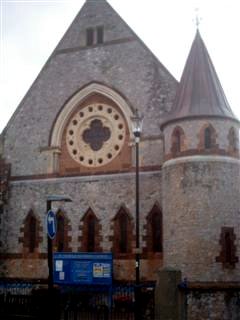 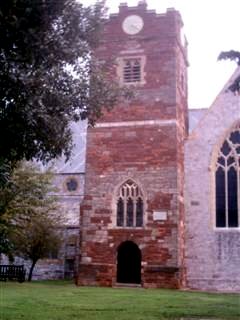 |
| Around and About Outside
Twenty seven Fore Street displays the date it was built (1693). Cromer House is C18th and it's neighbour C19th. No.48 was the Custom House until 1826 but was constructed in 1708. White Street is now a street of very desirable cottages but was once Topsham's red light area. The Quay end of Holman Way is at the mini-roundabout. A barrier at this point, once controlled the railway branch line which followed the path of Holman way. The road itself was built in order to ease traffic flow when Topsham's drainage system was laid in the 1970's. |